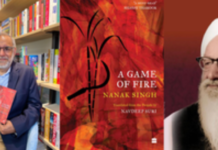
By Arul Louis
New York– Former US President Barack Obama unleashes the West’s worst stereotypical picture of India as a country with “all-too-pervasive” violence and politics revolving around “religion, clan, and caste” in his latest memoir and yet in the same breath talks about Sonia Gandhi, a “mother of European descent”, emerging as the most powerful politician who is able to appoint Manmohan Singh from a minority as prime minister.
“Across the country, millions continued to live in squalor, trapped in sunbaked villages or labyrinthine slums, even as the titans of Indian industry enjoyed lifestyles that the rajas and moguls of old would have envied,” he writes in his new memoir, “A Promised Land”.
He writes, “Violence, both public and private, remained an all-too-pervasive part of Indian life.”
Obama, the son of a Kenyan father and a White American mother, with a sometime Indonesian step-father, pretending to labour under the time-worn cliche of bearing the “Whiteman’s burden”, in a broad sweep encapsulates the nation in its entirety with these images.
The image of India he offers up with supercilious condescension to his readers is not something he had seen for himself, as he acknowledges not having travelled to the country before becoming president, although “the country had always held a special place in my imagination”.
“Expressing hostility toward Pakistan was still the quickest route to national unity” in India, he writes.
As if India shouldn’t develop nuclear weapons as a deterrent to Pakistan’s N-bomb, he writes, many Indians take “great pride in the knowledge that their country had developed a nuclear weapons program to match Pakistan’s, untroubled by the fact that a single miscalculation by either side could risk regional annihilation”.
He cannot ward off the temptation to lay on stereotypes, although he starts off acknowledging that “in many respects, modern-day India counted as a success story, having survived repeated changeovers in government, bitter feuds within political parties, various armed separatist movements, and all manner of corruption scandals”.
“The transition to a more market-based economy in the 1990s had unleashed the extraordinary entrepreneurial talents of the Indian people — leading to soaring growth rates, a thriving high-tech sector, and a steadily expanding middle class… and Prime Minister Manmohan Singh’s economic reforms lifted millions out of poverty”, he writes.
But reverts to stereotype: “Despite its genuine economic progress, though, India remained a chaotic and impoverished place: largely divided by religion and caste, captive to the whims of corrupt local officials and power brokers, hamstrung by a parochial bureaucracy that was resistant to change.”
Obama and his wife reportedly received $65 million as advance from their publisher for their memoirs.
“A Promised Land” ends with 2011 and the next volume is to pick up after that. For that reason Prime Minister Narendra Modi does not figure in the book.
The ascent to prime ministership by Singh, a member of “often persecuted Sikh religious minority,” he writes, “sometimes heralded as a hallmark of the country’s progress in overcoming sectarian divides, was somewhat deceiving”.
“More than one political observer believed that she’d chosen Singh precisely because as an elderly Sikh with no national political base, he posed no threat to her 40-year-old son, Rahul, whom she was grooming to take over the Congress Party,” Obama writes.
But Obama is smitten with Singh, whom he describes as “wise, thoughtful, and scrupulously honest” and “man of uncommon wisdom and decency” with a white beard and a turban that “to the Western eye lent him the air of a holy man”.
He writes that with Singh, he developed “a warm and productive relationship” and forged agreements for cooperation on counterterrorism, global health, nuclear security, and trade despite a bureaucracy’s historic suspicion of the US”.
Already in 2010, when they had a private chat without their aides before a dinner, Obama indicates that Singh had premonition of the rise of the BJP and Obama writes that he too “wondered what would happen when he left office”.
“Somehow, I was doubtful” that the baton would be passed on to Rahul Gandhi according to his mother’s plan “and preserving the Congress Party’s dominance over the divisive nationalism touted by the BJP”.
He says it wouldn’t be Singh’s fault and wonders if “violence, greed, corruption, nationalism, racism, and religious intolerance” were “too strong for any democracy to permanently contain”.
Perhaps in a dig at Donald Trump, who succeeded him, he writes that “they seemed to lie in wait everywhere, ready to resurface whenever growth rates stalled or demographics changed or a charismatic leader chose to ride the wave of people’s fears and resentments”.
Obama describes meeting Sonia Gandhi at a dinner hosted by Singh, calling her “a striking woman in her sixties, dressed in a traditional sari, with dark, probing eyes and a quiet, regal presence”.
It was clear, he writes, that the power of the “former stay-at-home mother of European descent” could be attributed “to a shrewd and forceful intelligence”.
During the dinner, Obama says that Sonia Gandhi deferred to Singh on policy matters, but tried to steer the conversation to her son.
Obama describes Rahul Gandhi as seeming to be “smart and earnest, his good looks resembling his mother’s”.
He spoke about “progressive politics,” Obama write, “occasionally pausing to probe me on the details of my 2008 campaign”.
“But there was a nervous, unformed quality about him, as if he were a student who’d done the coursework and was eager to impress the teacher but deep down lacked either the aptitude or the passion to master the subject,” Obama concludes.
He mentions that his introduction to India from Indian and Pakistani college friends who had “taught me to cook dahl and keema and turned me on to Bollywood movies”.
And, growing up in Indonesia, he writes, he had listened to the Mahabharata and Ramayana. (IANS)













